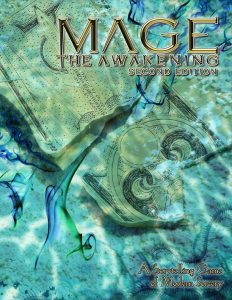 The upcoming Signs of Sorcery is about all forms of Supernal contact with the Fallen World. One of the topics it covers is Artifacts and related magical items. You’ll have to wait for the book to read about Eidoforms, Astras, and Manteions, but here for your reading pleasure is the section on Sariras.
The upcoming Signs of Sorcery is about all forms of Supernal contact with the Fallen World. One of the topics it covers is Artifacts and related magical items. You’ll have to wait for the book to read about Eidoforms, Astras, and Manteions, but here for your reading pleasure is the section on Sariras.
First mentioned in Awakening’s first edition corebook as “Crystal Dragon Bones,” but not fully explained until Imperial Mysteries, Sariras are the after-effects of a mage Ascending. They’re highly prized by the Awakened, both as inspirational relics and for their use as powerful Artifacts. They’re written up in Signs by Mage freelancer extraordinary Malcolm Sheppard. In this example, I think Malcolm hit “Peak Mage.”
Some willworkers believe that when a mage Ascends, her soul discards her body for the Supernal Realms, but dedicated scholars know that Ascension takes body and soul. An Ascension might appear to leave a body behind, but it’s actually a Sarira: a duplicate made of solidified Resonance and traces of the departed mage’s Nimbus.
A Sarira doesn’t look exactly like a corpse. Its bones turn to crystal. Its former Path or strongest Arcanum influences its appearance, so that an Ascended Obrimos might faintly glow, and an Acanthus’ hair turns into thorny metallic vines. Jewels decorate its chakras. A Sarira might take the form of a weathered granite statue or humanoid tree. Tellingly, it doesn’t decompose and can’t be affected by Death or Matter spells. Despite its solidity and appearance, it registers as a bundle of potent Resonance, not a corpse or inanimate, material object. Many believe Sariras explain myths about crystal skulls, incorruptible saints’ relics, and Atlantean “dragon bones.”
A complete Sarira possesses the powers of a 10 dot Artifact as well as the following systems, which may change or override the usual rules.
Supernally Incorruptible: No spell, Attainment or supernatural power can directly affect a Sarira or its Resonance. The sole exception consists of spells that can siphon Mana. These can withdraw Mana from its Tass-like matrix but can’t replace it. Supernaturally triggered or enhanced external phenomena function normally. You can conjure a ball of fire to throw at it, but can’t make it spontaneously combust.
Divisible: Despite their resistance to supernatural powers, Sariras can be chopped into pieces and even destroyed with steady hands and sharp tools. An intact Sarira possesses Structure 50, Durability 5. Each dot of Artifact power maintains the same Durability, and 5 Structure; a 3-dot portion possess Structure 15, for instance. A piece’s power and relative toughness isn’t related to its Size, but its symbolic importance. A leg might be less potent than a petrified pineal gland.
Every 5 points of damage reduces a Sarira’s Artifact powers by 1 dot, and releases its Mana portion per dot (see below) back to the Supernal Realms.
Separating a Sarira into pieces in any methodical fashion requires a successful Dexterity + Occult roll, with a risk of Dramatic Failure, for a process that requires one hour of careful work. Dramatic Failure inflicts 5 points of damage, with the aforementioned consequences. Successes scored indicate the maximum Artifact dots that can be separated, with an absolute limit of 5, though the mage can opt to cut away something with a lower rating of her choice. Having at it with an ax, a prayer and no dice roll, automatically inflicts 5 points of damage and the attendant consequences over the course of an hour, and separates a piece as powerful as the Storyteller wants it to be. (By default, roll a die and halve the result, rounding up. The piece has that many dots.)
Chopping up a Sarira is a Low Act of Hubris. The mage mars a physical sign of Ascension and risks destroying it.
Dynamic Artifact: As noted, an intact Sarira possesses the powers of a 10 dot artifact. If divided into portions with lesser dot ratings or damaged, the Sarira’s powers change to accommodate the new dot rankings of each surviving portion. The altered Sarira will manifest powers as close to their original forms as possible. For example, a Sarira with two five dot powers split into two five dot parts might transfer one power to each part. If one of those parts is damaged and reduced to three dots, the power might change to one from the same Arcanum. The Sarira’s powers usually emulate the personality and magical specialties of the Ascended one who left it behind.
Calculate the inherent Gnosis of a Sarira separately for each component part, based on its current state and powers.
Body of Mana: A Sarira resembles Tass, and its matrix binds Mana. Use the following guidelines instead of the Mage core’s rules for Mana in Artifacts. Each Sarira dot encompasses 10 points of Mana. An intact Sarira accumulates 1 point per dot per century. Once the Sarira has been divided or damaged to the point where it loses 1 dot or more of value, this process ceases. Spending an Artifact dot’s “share” of per-dot Mana eliminates the dot permanently, and part of the Sarira crumbles or evaporates. Dot loss halts Mana accumulation permanently. Mages interested in preserving a Sarira avoid using its stored Mana.
Resonance: Each dot value in the Sarira possesses one Resonance Trait linked to the Nimbus and character of the Ascended mage it represents. This Resonance can’t be magically suppressed or altered, but can be used when the mage siphons Mana from the Sarira or makes bare-skinned contact with it.
Supernal Tool: A Sarira provides the benefits of dedicated magical tool for any mage who belongs to the same Path as the Ascended, but doesn’t require attuning or impose a closer sympathetic connection. Consequently, as the manifestation of another willworker’s Ascension, it cannot be dedicated for any additional benefit.
Sample Sarira: The King Who Is a Throne (10 dot Sarira)
Structure 50, Durability 5, Size 5, Gnosis 5, Mana 200
One of the few intact Sariras known to exist, the King Who Is a Throne sits beneath an apartment complex in Ordos City, China. Before that the King stayed in Nepal, in a cave reserved for ascetics who practiced body-warming yoga. The Mysterium explorer Yang Zenli sensed its mighty Resonance, gathered a team to acquire it and overcame… Nothing. It was just sitting there. That scared the shit out of him, so he dumped it in a place he figured nobody would look, in a neighborhood built by real estate speculation but devoid of inhabitants except for security guards and maintenance workers. He now owns that corner of Ordos. Most days, he tells himself he’ll build an Athenaeum there, and develop a community where the Awakened can study in peace. Of course he can’t, because he doesn’t know what to do with the fucking King. He’s read the right scrolls. He’s interrogated monks and archeologists at length. They say that a thousand years ago, the King decided to take the path the Buddha refused and become a Chakravartin, or universal ruler. He became the power behind the Pala Empire but vanished after promising to return with divine weaponry and a plan to bring the world to heel. After 108 days, his servants found his Sarira, seated on a stone stool.
Yang worries about the many, many people who’d kill him for the intact King, but he’s also terrified of attracting the interest of the Ascended being itself. For all he knows the King is an Exarch, or plans to come back, just as he promised.
But he found the King performing a humble service, as a seat for the odd yogi to relax in between periods of exercise. The King Who Is a Throne has fused with his stool. He sat up straight, hands on his knees but elbows out, and he was a big man, too. Throw a cushion on there, and he’d be quite comfortable to sit on. Yang’s research uncovered a history of petty occultists and feudal lords who used the King this way for special occasions. Many of them burned to death. So did their palaces. So did forests and farms surrounding the palaces.
The King has a skull face with sapphires for eyes but he’s a muscular man. Lines of iron trace yogic nadi (energy channels) across his body. This flows into the black scale armor covering his torso and thighs and a spiked crown unlike anything an Asian potentate would wear.
The King Who Is a Throne possesses the following Resonance Traits and their associated keywords: Ambitious, Bright, Burning, Crackling, Domineering, Martial, Raging, Terrifying, Tempestuous, and Thunderous. It possesses the power to cast “Celestial Fire” (Prime ••••), “Psychic Domination” (Mind ••) and “Transform Energy” (Forces ••••). The King was an Obrimos, and lends his Supernal Tool benefit to members of that Path.
Sariras in the Chronicle
As material evidence of Ascension, Sariras assure mages that it’s real, attainable — and mysterious. They also signify the fleeting nature of truth in the Fallen World. Use one, and it diminishes, eventually vanishing forever. The fact that they can be split up tempts sorcerers to compromise them for selfish or politically-driven reasons.

I was literally thinking it had been a while since we had a Mage update last night. Thank you!
This is pretty neat, I like the idea of how sariras work and this particular one is very cool.
What is ‘Low Act of Hubris’? We have this line in text – ‘Chopping up a Sarira is a Low Act of Hubris.’ – Does it mean Falling AoH?
Wisdom breaks don’t work at each number of Wisdom, instead they’re divided into sections, High, Medium, and Low. It’s a Break for everyone above 0 Wisdom and you only have 1 die.
MAGE’s updates are amazing! Imperial Mysteries is one of the best RPG books I’ve ever read and I think Signs of Sorcery won’t lag behind… Cheers
The powers listed for the sample Sarira are only equivalent to a 7 dot artifact, not 10 (The cost of an Artifact is the highest Arcana used in its highest spell, plus half the rating rounded up for each additional spell).
Is this intentional?
Yes, it seems wrong.
One, based on this and other previews i was wondering. what’s the difference between a sarira and eidoform?
and two. THIS IS AWESOME!! DAVE AND MALCOME YOU GUYS DID IT AGAIN
Interesting, does this mean that sariras relate metaphysically to soul stones?
As for the king, I just can’t help but think of a weaponized version of the Emperor’s corpse from 40K. Extra heretical.
I’m not sure if Resonance traits are like the so named Conditions or a Nimbus Tilt…possibly both…
I hope this is addressed in Signs of Sorcery.
BTW; this is fairly awesome…and a part of me is giving a hunch of these to the big Seer Ministries…who often chop them up.